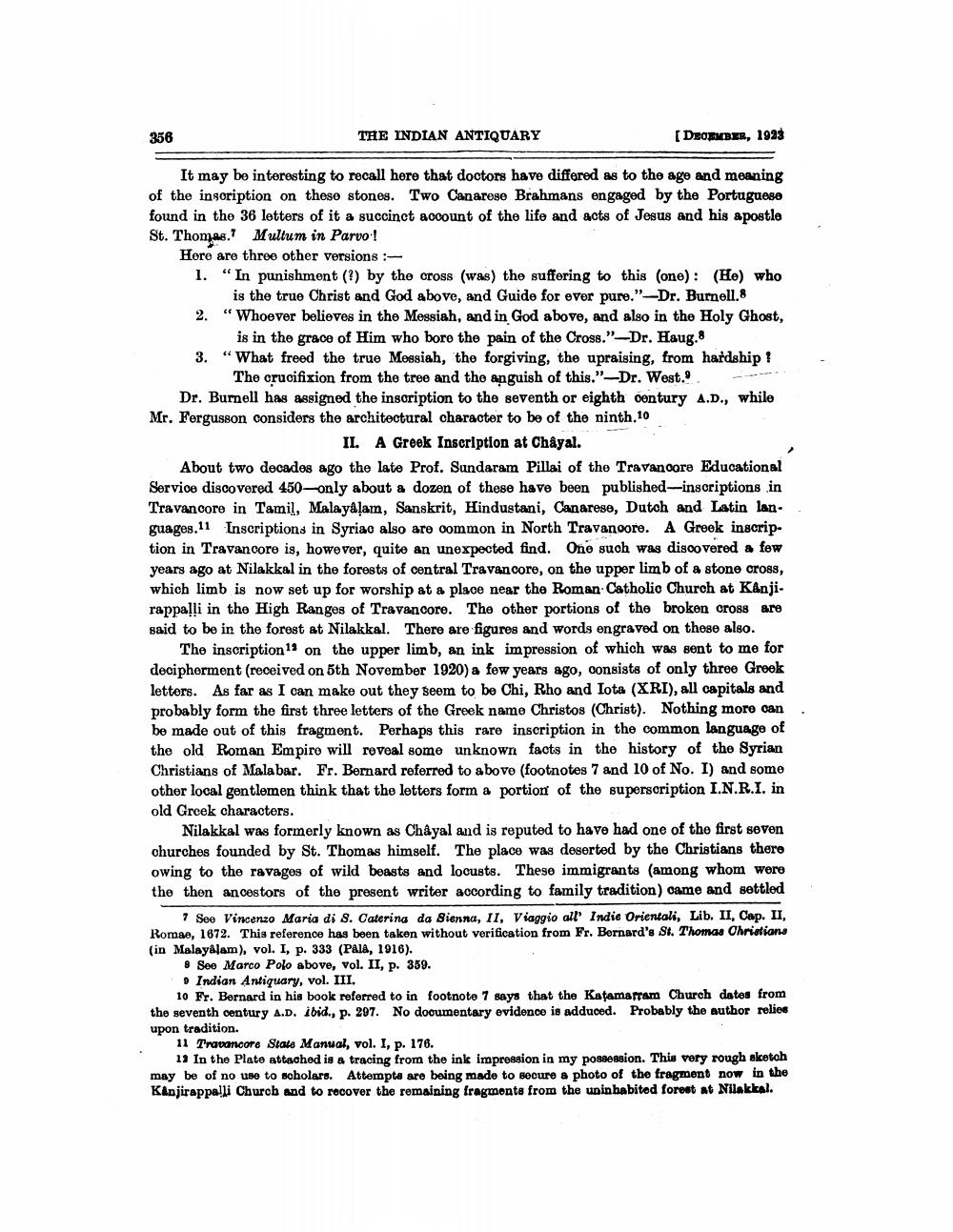________________
356
THE INDIAN ANTIQUARY
(DOBBER, 1993
It may be interesting to recall here that doctors have differed as to the age and meaning of the insoription on these stones. Two Canarese Brahmans engaged by the Portuguese found in the 36 letters of it a succinct account of the life and acts of Jesus and his apostle St. Thomas. Multum in Parvo !
Here are three other versions : 1. "In punishment (?) by the cross (was) the suffering to this (one): (He) who
is the true Christ and God above, and Guide for ever pure."-Dr. Burnell.8 2. "Whoever believes in the Messiah, and in God above, and also in the Holy Ghost,
is in the grace of Him who bore the pain of the Cross."-Dr. Haug.8 3. “What freed the true Messiah, the forgiving, the upraising, from hardship!
The crucifixion from the tree and the anguish of this."-Dr. West. Dr. Burnell has assigned the inscription to the seventh or eighth century A.D., while Mr. Fergusson considers the architectural character to be of the ninth 10
II. A Greek Inscription at Châyal. About two decades ago the late Prof. Sundaram Pillai of the Travancore Educational Service discovered 450-only about a dozen of these have been published-inscriptions in Travancore in Tamil, Malayalam, Sanskrit, Hindustani, Canarese, Dutch and Latin languages.11 Inscriptions in Syriao also are common in North Travancore. A Greek inscription in Travancore is, however, quite an unexpected find. One such was discovered a few years ago at Nilakkal in the forests of central Travancore, on the upper limb of a stone cross, which limb is now set up for worship at a place near the Roman Catholic Church at Kanji. rappalli in the High Ranges of Travancore. The other portions of the broken cross are said to be in the forest at Nilakkal. There are figures and words engraved on these also.
The inscription 1' on the upper limb, an ink impression of which was sent to me for deciphorment (received on 5th November 1920) a few years ago, consists of only three Greek letters. As far as I can make out they seem to be Chi, Rho and lota (XRI), all capitals and probably form the first three letters of the Greek name Christos (Christ). Nothing more oan be made out of this fragment. Perhaps this rare inscription in the common language of the old Roman Empire will reveal some unknown facts in the history of the Syrian Christians of Malabar. Fr. Bernard referred to above (footnotes 7 and 10 of No. I) and some other local gentlemen think that the letters form a portion of the superscription I.N.R.I. in old Greek characters.
Nilakkal was formerly known as Châyal and is reputed to have had one of the first seven churches founded by St. Thomas himself. The place was deserted by the Christians there owing to the ravages of wild boasts and locusts. These immigrants (among whom were the then ancestors of the present writer according to family tradition) came and settled
7 See Vincenzo Maria di S. Caterina da Sienna, I1, Viaggio all' Indie Orientali, Lib. II, Cap. II, Romae, 1872. This reference has been taken without verification from Fr. Bernard's St. Thomas Christians (in Malayalam), vol. I, p. 333 (Pala, 1916).
9 See Marco Polo above, vol. II, p. 359. 9 Indian Antiquary, vol. III.
10 Fr. Bernard in his book referred to in footnote 7 says that the Katamarram Church dates from the seventh century A.D. ibid., p. 297. No documentary evidence is adduced. Probably the author relies upon tradition.
11 Travancore State Manual, vol. I, p. 176.
12 In the Plate attached is a tracing from the ink impression in my possession. This very rough alcetoh may be of no use to soholars. Attempts are being made to secure a photo of the fragment now in the Kinjirappalli Church and to recover the remaining fragments from the uninhabited forest at Nilakkal.




